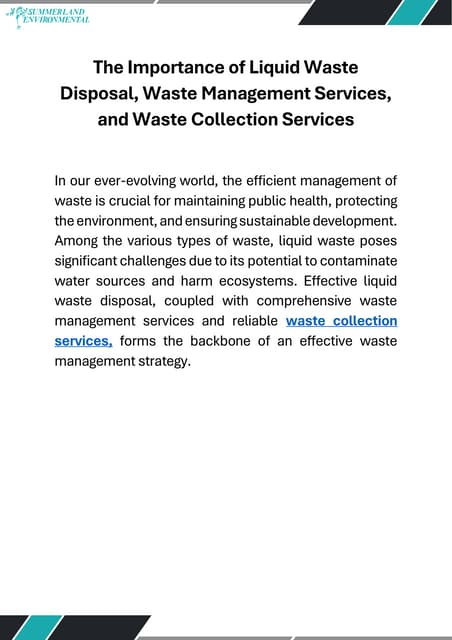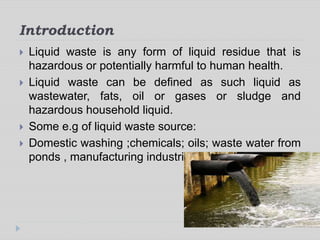How Reclaim Waste can Save You Time, Stress, and Money.
How Reclaim Waste can Save You Time, Stress, and Money.
Blog Article
The 5-Second Trick For Reclaim Waste
Table of ContentsThe 2-Minute Rule for Reclaim Waste9 Easy Facts About Reclaim Waste ExplainedThe Ultimate Guide To Reclaim WasteThe smart Trick of Reclaim Waste That Nobody is DiscussingExamine This Report about Reclaim Waste
Domestic sewer waste refers to the waste and products from a property septic tank. The correct monitoring and disposal of residential sewer waste require liquid waste to be moved to a sewage therapy plant where the correct methods and devices are applied to cleanse and dispose of waste.
Industrial waste usually includes possible risks, such as combustible products or a combination of fluid and solid waste items, and needs a much more innovative and comprehensive disposal process. The disposal of business waste usually includes the filtering of waste before transportation to make sure secure and appropriate disposal. Industrial waste is created from results and overflow of industrial processes and production.
This sort of waste can not utilize the very same sewer monitoring transportation or processes as septic or commercial liquids. The hazardous waste administration process needs the examination and screening of liquid waste prior to it undergoes the disposal process (liquid waste disposal). Overflow waste is the fluid waste that originates from runoff and excess stormwater in very booming locations or cities
Runoff waste can cause contamination and flooding if not handled appropriately. Making sure correct waste monitoring can protect against catastrophes and minimize environmental harm.
What Does Reclaim Waste Do?
Get in touch with PROS Services today to learn more about our waste administration and disposal solutions and the correct methods to look after the fluid waste you produce.
(https://disqus.com/by/reclaimwaste1/about/)This supposed 'wastewater' is not only an important resource but, after therapy, will certainly be released to our land, rivers or the ocean. Utilized water from commodes, showers, bathrooms, kitchen area sinks, washings and commercial procedures is known as wastewater.

water made use of to cool down equipment or tidy plant and tools). Stormwater, a kind of wastewater, is overflow that moves from farming and city areas such as roofing systems, parks, yards, roadways, courses and rain gutters into stormwater drains pipes, after rain. Stormwater flows unattended directly to local creeks or rivers, ultimately reaching the sea.
Fascination About Reclaim Waste
In Queensland, the majority of wastewater is treated at sewer treatment plants. Wastewater is carried from residential or industrial sites via a system of drains and pump terminals, called sewerage reticulation, to a sewer treatment plant. Regional governments develop, maintain and run most sewer treatment plants. Operators are accredited under the Environmental Security Act 1994 to release cured wastewater at an appropriate ecological standard right into rivers.
The Department of Natural Resources encourages regional federal governments about managing, operating and preserving sewage systems and therapy plants. In unsewered locations, neighborhood federal governments may call for owners to set up private or home sewer therapy systems to deal with residential wastewater from bathrooms, my site kitchens, restrooms and laundries. The Division of Natural Resources authorises the usage of household systems when they are verified to be reliable.
In some brand-new neighborhoods, treatment of some stormwater to eliminate litter, sand and crushed rock has actually begun utilizing gross toxin catches. Wastewater treatment happens in 4 phases: Eliminates strong issue.
Makes use of small living microorganisms knows as micro-organisms to damage down and remove staying liquified wastes and great fragments. Micro-organisms and wastes are integrated in the sludge.
Reclaim Waste Fundamentals Explained
Nutrient removal is not available at all sewer therapy plants since it calls for pricey specialist tools. It is coming to be more typical in Queensland. Clear fluid effluent generated after therapy may still include disease-causing micro-organisms. If this effluent is released right into rivers such as rivers or the sea, the micro-organisms will at some point die out.

Many wastewater flows right into the sewage system. Under the Act, neighborhood governments provide approvals and permits for environmentally pertinent activities (ERAs) entailing wastewater releases that may have a local influence.
Reclaim Waste Fundamentals Explained
Tracking supplies valid information regarding water high quality and can verify that licence problems are being fulfilled. The details gotten through surveillance gives the basis for making water quality choices.
Report this page